15th FEBRUARY. At midnight on the 14th the bombardment re-commenced and went on for an hour and a half.
Trenches were slightly damaged and communication trenches knocked about a good deal, but this was repaired by 6 a.m.
A patrol went round the crater and found no trace of the Germans.
The bombardment started again at 8 p.m and continued to 11 p.m.
The South Staffs reported little or no progress in their counter attack.
The work of digging into the crater was hampered by bodies having to be removed from the trench as it was cleared.
At 7 work started to dig a new trench behind the crater and was continued across the Zillebeke road 30 Yards.
|

Capt Cecil C Jervelund.
|
16th FEBRUARY. Lt Cecil Christian Jervelund was promoted to Captain.
His name is not mentioned in the War Diary after this date and it is likely that he was attached to some other Unit.
He had been an Officer with the 4th Yorks since 1913 and went to France with them on 18th April 1918.
He was the son of a Danish Merchant and in 1911 was living at a large 16 room house, 23 Teresa Tce, Coatham, Redcar, N Yorks.
He worked at that time as a Clerk at the local Iron and Steel Works. His elder brother Charles was a regular Officer in the
Yorkshire Regiment and served in the War.
Two of his cousins, who were brothers lost their lives in the War:-
CQMS Andris Jevelund of the 5th Battn Northmberland Fus was killed in action on March 22nd 1918
Pte Frank Jervelund of the 8th Yorks Battn killed in action on the 10th July 1916 in the Somme offensive.
Cecil Jervelund was possibly wounded at some time, as he survived the War and appears again in October 1920 when he was once more
made a Captain in the 4th Yorks Battalion after they reformed as part of the new Territorial Army.
He married Marguerite D Mangin in Ripon, Yorks in 1918.
Died in 1942 at Middlesbrough, N Yorks.
|

|
1588 Pte Cole Ralph. Home at - 37 Arthur Tce, New Marske N Yorks, place of birth.
Enlisted at Skelton in Cleveland, N Yorks. Killed in action. Age 20. Buried at Railway Dugouts Burial Ground.
[Photograph kindly contributed by Mick Trainor of New Marske, N Yorks.]
Local paper notice:-
COLE - Killed in action, February 14th, 1916, somewhere in France, Pte Ralph Cole,
of the 4th Yorks, dearly-beloved son of Arthur and Susannah Cole, of New Marske,
aged 20 years. Deeply mourned by all.
|
3954 Pte Robinson Thomas, Francis. Enlisted at Middlesbrough, N Yorks. Died of wounds. Buried at Lijssenthoek
Military Cemetery.
Mrs Robinson, 26 Lime St, Middlesbrough, mother of Pte T.F Robinson, 4th Yorks, has received the following letter from Lieut G. H. Hutchinson :-
Dear Mrs Robinson,
I am very sorry to have to convey to you the sad news of the death of your son, which occurred on Feb 16th. We had a tremendous bombardment on February 14th, when your son was wounded in the head by shrapnel.
He was attended to at once by the stretcher bearers and made as comfortable as possible in a dug-out until the bombardment ceased and was then taken to hospital.
I believe he would be unconscious most of the time, as he lost consciousness soon after he was wounded.
I hope you will accept my deepest sympathy, also that of the NCSs and men of this Company. He and others who passed away at the same time will be a great loss to us all, and their country for whom they were fighting.
17th FEBRUARY.
|
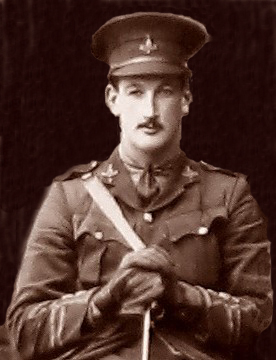 Capt John Maughan.
Capt John Maughan.
|
Capt John Maughan was killed in action. Age 26.
He was the eldest son of John Maughan, of Abbey Hill, Jervaulx, Middleham, Yorks. Educated at Marlborough College, where
he was an active member of the Officer Training Corps.
Born January 4th 1890. He joined the Regiment in 1908, and was gazetted Captain in November, 1914. He went to France with the 4th Yorks in
April 1915 and took part in all the subsequent engagements.
He was mentioned in General French's Despatches. He is buried at Poperinghe New Military Cemetery.
18th FEBRUARY.
3887 Pte Mackenzie John. Home at - 8 Farrar St, Norton Rd,Stockton on Tees.
Enlisted at Northallerton, N Yorks. Killed in action. Age 19. Commemorated on the Menin Gate Memorial Ypres. Local paper notice -
MACKENZIE - Killed in action, near Ypres, February 18th, Pte John Mackenzie, 4th Yorks,
aged 19 years 6 months, youngest beloved son of Colin and Hannah Mackenzie, 8 Farrer St,
Stockton.
Sadly missed by his father and mother, sister and brother. He answered his call.
|
The situation stayed fairly quiet after the 15th and trench restructuring carried on. At night on this day the Bn were
relieved by the 8th Bn DLI and marched back to Canada Huts, Dickebusch.
The relief passed off well with the exception of the Lewis guns which were misdirected by the Staff Office on road
control, which delayed 151st Brigade an hour.
The five days on Hill 60 had seen 3 Officers and 22 other ranks killed. 2 Officers and 62 other ranks had been wounded.
19th to 23rd FEBRUARY.
|
 Lt Anthony R Welsh.
Lt Anthony R Welsh.
|
Lt. Anthony Reginald Welsh. Territorial Force, Age 32. Died of Wounds. Born at Altrincham, Cheshire on December 23rd 1883.
He was the only son of William Welsh of Owslebury House, near Winchester, and of Florence Elvira his wife, daughter of Charles Manley
Smith, formerly a Master in the Supreme Court of Judicature.
He entered Rugby Public School, Warwickshire with a Scholarship in 1896, and in the Scholarship list of the next year was placed first in
Classics, first in Modern Languages and third in Mathematics. He excelled also in Science and was an enthusiastic botanist.
He was in the Running VIII in 1900, 1901 and 1902, and Captain in his last year, and won the Crick in 1901 and 1902, beating
the previous record. In 1902 he held the Athletic Cup.
He won the first General Exhibition when he left Rugby in July, 1902, and went up to Trinity College, Cambridge, with a Major Classical
Scholarship.
At Cambridge he was in the First Class in the Classical Tripos of 1904, and in the Second Class in the Mechanical Science Tripos of 1906.
He ran for the University in the four years 1902-5 against Oxford in the cross-country race at Roehampton. In 1906, at the Inter-University
Sports at Queen's Club, he won the Mile in 4 mins. 21 secs. and the same after-noon ran second in the Three Miles.
After leaving Cambridge he was employed on the staff of Messrs.Mather and Platt, of Manchester, who entrusted him with
|
important work in Canada and in India.
He subsequently became secretary to Messrs Bell Brothers, Ironmasters, at Middlesborough, N Yorks.
At the outbreak of War, he received his Commission in September,1914, and went to the Front in France in April, 1915, when he took part
in the Second Battle of Ypres.
He was wounded on May 3rd, and again on June 22nd, each time in the head, but soon returned to duty. He was promoted Lieutenant at the end
of May, and was mentioned in Despatches of November 30th, 1915.
In rest billets close to Armentieres in late October, Lt Welsh was among a party chosen from the battalion for a review by the King at
Bailleul.
He was wounded a third time in the Ypres Salient on February 16th, 1916 when the Germans blew a mine underneath Hill 60.
He died at No 7 Stationary Hospital, Boulogne on February 19th 1916
Buried in Boulogne Eastern Cemetery.
His Colonel wrote:- �He was loved by us all both Officers and men for his courage, kindliness and reliability�.
|
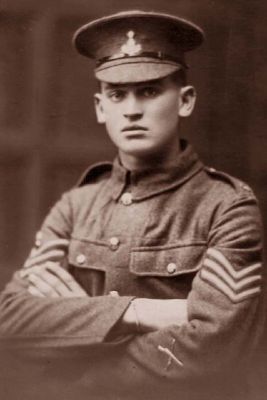
|
3571 Pte Dove Robert. Home at 16 Dale Tce, Lingdale, N Yorks. Died on the 20th age 35. Buried at St Aidan Churchyard, Boosbeck, N Yorks.
The Bn bathed and cleaned up. Training continued "on the old and never ending lines".
The Lena Ashwell concert party performed in the YMCA hut.
On the 22nd there was much snow.
24th and 25th FEBRUARY. The Bn to Close support in reserve trenches in the Armagh Wood area. Headquarters was in
Maple Copse.
They occupied dugouts named Border, Cumberland and Consett. The weather was severe.
Sgt Wilf Thornton.
Later commissioned into the 4th Bn and taken prisoner in March 1918 in the Somme area.
[Photograph kindly contributed by John Sheen, author of Tyneside Irish, Durham Pals, & Wearside Battalion.]
|
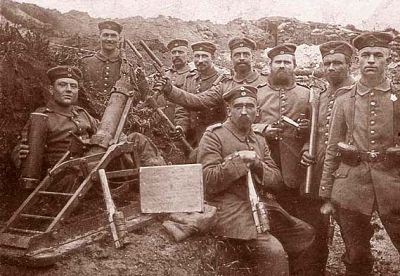 Germans in a trench with stick grenades, flare guns and a "Minenwerfer", Mine-launcher.
Germans in a trench with stick grenades, flare guns and a "Minenwerfer", Mine-launcher.
All the German Infantry were equipped with this Trench Mortar.
A shell weighing over 4 kilos, with a calibre of 7.5 centimetres was loaded into the muzzle of the weapon and
could be fired over 1,000 metres to explode on impact.
|
Diary "In view of the attack on the Bluff, the Bn was ordered to put the reserve Line in a state of defence"
26th FEBRUARY. Fred Tyerman, who was to be killed next day, wrote his mother:-
"Just to let you know that I and Will [his brother, who was killed 4 days later] are still alright,
hoping by the time you receive this that you are very much better.
...We have got your P.C. [postcard] and parcel alright, and thanks very much for it.
We are in the trenches at present but we are having a decent time and very quiet.
We have had a little snow, but not much and we are not taking any harm up to the present.
I suppose you will have heard by now about the Northallerton fellows going down, but still we have to be thankful that
we are still here.
The Officer who I was servant to when I was at home there got wounded, but has since died of wounds.
[Lt A R Welsh on the 19th]
My word it is hard lines when all the best ones are taken from you. Captain Stead also got wounded but his was not
serious. He is down at the base now but we are expecting him back any time.
Well, Mother, I must close now, so no more at present.
With best love from Will and Fred. XXXXXXXXXXXXXXXXX"
|
1813 Pte Tyerman Fred. Home at Brompton, Northallerton, N Yorks, place of birth and
enlistment. Killed in action on the 27th. Commemorated on the Menin Gate Memorial, Ypres. Memorial stone commemorating
the burial of two brothers, side by side, before the cemetery was later destroyed by shellfire at Maple Copse
Cemetery.
|

Richard [Dick] Locker seated with his brother Robert.
[Photograph kindly contributed by a friend of East Cleveland Image Archive.]
|
At about 10.30 am. Fred Tyerman was working as batman for his new officer, Capt. Sproxton after
his previous charge, Lt. Welsh, had been wounded and died of his wounds in hospital at Boulogne.
He was in the officer's dugout busy preparing breakfast when a shell scored a direct hit, mortally wounding Fred,
who died a few minutes later.
28th FEBRUARY.
The following two men were killed in action and are buried in Maple Copse Military Cemetery.
2875 Pte Bower William. Home at - Carlin How, N Yorks. Born Warrington, Lancs.
Enlisted at Skelton in Cleveland, N Yorks.
1162 Pte Wilks Arthur. Home at Cliff Terrace, Great Ayton, N Yorks, place of birth.
Enlisted Stokesley. Age 21.
He was the son of Arthur Edward Wilks, a Gt Ayton man, who worked as an Engine Driver in the Ironstone Mines and Hannah Elizabeth [Mohun] of Potto, N Yorks.
In 1901, aged 7, he was living in Mount Pleasant, Gt Ayton and in 1911, at 14 Cliff Tce and working as a Horse Driver in the local mine.
3164 Pte Locker Richard, George. Home at - 4 High Row, Loftus, N Yorks, place of
enlistment. Died of wounds on the 29th. Age 23. Buried at Vlamertinghe Military Cemetery.
His brother Robert was killed in action, age 22, on the 14th September 1918 while serving with the 2nd Battalion of the West Yorkshire Regiment. Sons of George Mann and Mary Jane Locker.
X and Y Companies of the Bn took over front line trenches A4 to A8 from the 5th D.L.I. W and Z Companies in
reserve trenches.
The weather was very snowy and cold. Most of the time was spent in getting up extra stores, rations and water for the
"Strafe".
There were no dugout shelters in trenches A7 and 8 and these were started along with trench repair and draining.
There was a lot of snow day and night on the 29th.
|
1st MARCH.
In preparation for an attack on the "Bluff" a "demonstration" was ordered.
The wind was not favourable for smoke bombs and for 20 minutes they kept up bursts of Lewis Gun and individual rifle
fire.
This caused the enemy to retaliate causing 3 other ranks wounded.
31 reinforcements were received.
Speech by Sir Joseph Walton in the House of Commons:-
The 4th Yorks Battalion was reduced by Whit Monday last year to half its strength, and for 3 months it had to do the full Battalion's work in the firing line without any men in the Support trenches.
After months of effort I got a promise that reinforcements would be sent out and 200 properly trained men were sent, but the balance were not half trained.
What was my surprise the other day when I discovered that out of the 200 trained men who were sent to France in October, only 30 went to join their Battalion, while 170 of them were employed making hurdles at the Base and it was 4 months after those 170 trained men landed in France before they arrived at the Front to join their Battalion.
Common sense would tell us that if they needed men to make hurdles they ought to have taken the half-trained men and sent the fully trained men to the Front to fight with their gallant comrades.
It would have been better still if they had sent 170 good old fashioned labourers over military age across to France. They would have made better hurdles than soldiers who have never made them in their lives.
The quality of goods obtained from the United States was also challenged by Sir Joseph.
He expressed the opinion that not �1 value was obtained for every �3 we sent there.
The cartridges, he said, were defective and as to the shells, he made the following declaration -
It is an absolute fact that on the day the 600 yards of trenches were taken by the Germans, 10 days ago, one of our baosted 8 inch howitzers sent 28 shells and out of these 28 only 4 burst.
No official statement has yet been made regarding these matters.
|
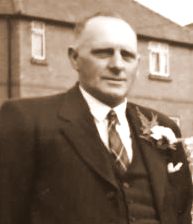
Pte Richard J Lean in 1952.
|
THE WOUNDED.
The thousand plus men who died in the First War while serving with the 4th Yorks have been recorded, if only briefly in many cases.
It is is much harder to find details of the great many more, who were wounded or gassed or debilated by trench diseases.
Mike Richardson has contributed details of his Great Grandfather, who was wounded about this time and eventually discharged.
2874 Pte Lean Richard John.
He went to France with the second draft in Sep/Oct 1915, after the 4th Yorks had lost so many men in the 2nd Battle of Ypres.
He was wounded at this time and eventually discharged on the 2nd June 1916.
He must have been shot or suffered shrapnel in the elbow, as his family recall that he did have a proper joint and could swing his arm around, but could still use his hand.
After the War he worked in the Skinningrove Steel Works and died of kidney failure in 1963.
|
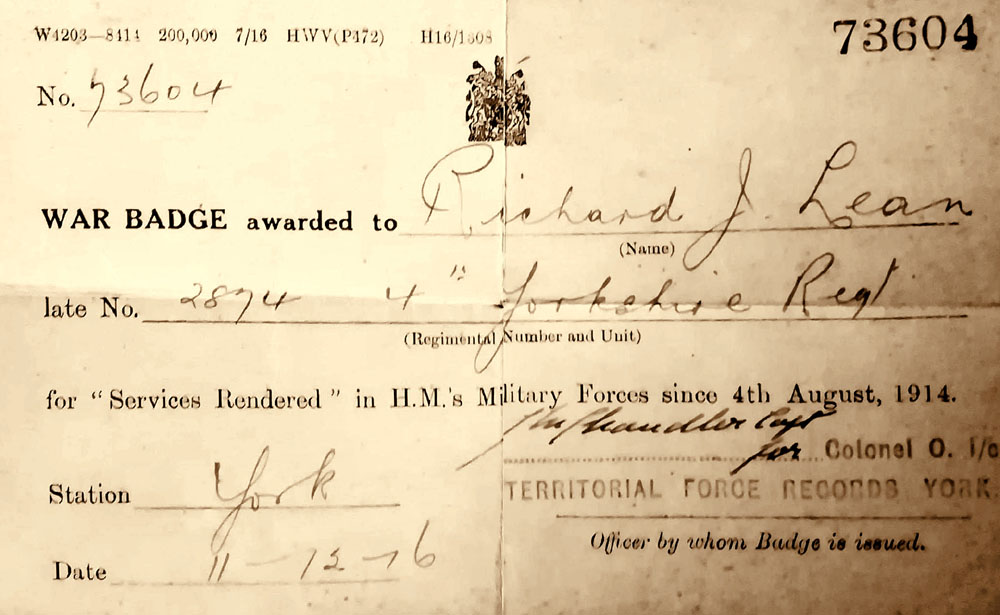
Men who were incapable of returning to serve were issued with a Silver Badge and this Certificate..
|
Go to Next page - Armagh Wood - CO Killed.
Go to Previous page - Mine Explosion on Hill 60..
Go Back to Contents.
|



